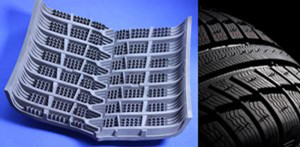Who knew that miraculously 3D printing complex objects out of metal could be so popular? After the acquisition of Phenix Systems, 3D Systems has seen its 3D metal printer series become the belle of the ball, shipping over two dozen of its ProX Direct Metal printers to a number of automotive tyre manufacturers. The new machines will allow tyre makers to create new, more intricate tread designs that would be impossible to produce with traditional methods.
 3D metal printing gives tyre manufacturers the ability to quickly produce tread moulds to test multiple design iterations before moving onto mass production. The slits on a tire’s tread, known as tyre sipes, need to be optimally designed to balance improved traction on wet surfaces versus stability on dry surfaces. In order to test new sipe concepts and other modifications, tyre manufacturers are turning to the ProX 300 to 3D print metal tyre moulds to test out design changes on the fly. In addition to being faster than machining or injection moulding metal parts, direct metal 3D printing allows for fully dense metal parts with thinner walls, sharper edges, and more complex details, including internal venting features, than their traditional counterparts. Currently, the ProX series can 3D print fifteen different metals, such as tool steel, stainless steel, super alloys, non-ferrous alloys, precious metals and alumina.
3D metal printing gives tyre manufacturers the ability to quickly produce tread moulds to test multiple design iterations before moving onto mass production. The slits on a tire’s tread, known as tyre sipes, need to be optimally designed to balance improved traction on wet surfaces versus stability on dry surfaces. In order to test new sipe concepts and other modifications, tyre manufacturers are turning to the ProX 300 to 3D print metal tyre moulds to test out design changes on the fly. In addition to being faster than machining or injection moulding metal parts, direct metal 3D printing allows for fully dense metal parts with thinner walls, sharper edges, and more complex details, including internal venting features, than their traditional counterparts. Currently, the ProX series can 3D print fifteen different metals, such as tool steel, stainless steel, super alloys, non-ferrous alloys, precious metals and alumina.
3D Systems’ Chief Impact Officer, Kevin McAlea, talked up the direct metal printing line by saying, “Our ProX series is designed to support manufacturing innovation in aerospace, automotive, medical device and heavy machinery. Metal 3D printing for industrial applications – as our customers are experiencing with our proprietary tyre tread manufacturing solution – offers enormous potential for businesses looking for complex end-use parts, as well as for rapid castings replacement for performance prototyping and final manufacturing.”
Intricate 3D printed moulds could lead to better traction and control for drivers, consequently improving auto safety, so, any improvements to tyre design is welcomed by me. Aside from taking us away from steam-powered cars and towards a more sustainable form of transportation, I wish the auto industry would replace rubber tires with something that wouldn’t pop and deflate so easily. When are these airless tires going to be ready already? I bet 3D printing could somehow bring them to me faster…
Source: 3D Systems

Leave A Comment